
Article contents

There’s no one best option when it comes to annuity or drawdown, just what’s best for you. An annuity provides a guaranteed retirement income for the rest of your life, so great for those who’d prefer certainty. Whereas pension drawdown gives you the flexibility to withdraw money when you’d like, while keeping your pension pot growing over time.
When it comes to pensions and retirement, there’s some very important decisions to be made – the big one is, should you opt for income drawdown or a pension annuity?
Income drawdown is where you simply withdraw money from your pension pot when you’d like (often monthly), while it’s still invested (so it can hopefully keep growing). You could think of it like a savings account where you’re earning interest (more money), but can spend your savings at the same time.
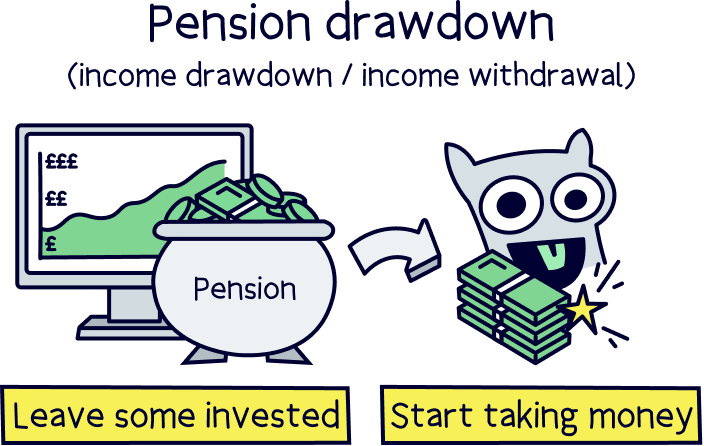
You don’t need to know anything about investing to go for the drawdown option – we’ll run through how you can easily get set up and make the right decisions below.
We recommend PensionBee, it’s easy to set up and use, low cost, with simple, easy to understand drawdown options.
An annuity provides a guaranteed income for the rest of your life (or a set period of time, e.g. 20 years). You typically ‘buy’ an annuity, by trading your pension in for it.
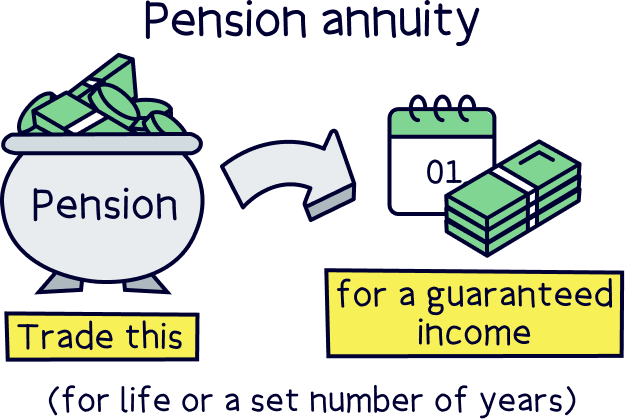
You can also do a bit of both if you want to.
Note: it’s becoming very popular to opt for drawdown these days – that’s because previously it wasn’t an option (before 2015), and provides a lot of flexibility.
In 2015, the Government changed the law to let us have more control over our pensions, and as a result, you could leave your pension where it was (invested), while withdrawing money from your pension from age 55 if you want to, and even take a 25% tax-free lump sum (explained below).
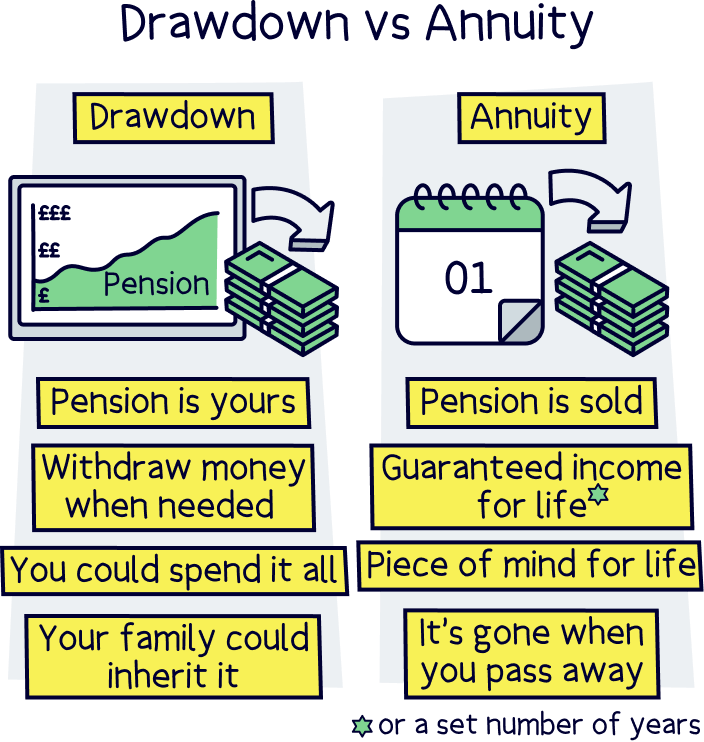
We’ll cover all the details of annuity and pension drawdown below, but if you think you’d like a bit of expert help, it can be a good idea to get financial advice – you can find great local advisors, for free, with Unbiased¹ (you’ll pay for the advice).
Note: if you opt for drawdown, you can always buy an annuity later on – however you can’t typically change your mind after you get an annuity.
And, if you’re opting towards drawdown already but unsure where to get started, here’s the best pension drawdown providers:
Let the experts manage your pension, and keep it growing over time, while withdrawing from it.
Get £50 added to your pension



PensionBee is our recommended provider – they’ve thought of everything.
Their 5 star rated app (and website) makes it easy to set up and use. You can open a brand new pension, or transfer your existing pensions across (they’ll handle all the paperwork).
Simply pick from an easy to understand range of pension plans, and that’s it, the experts manage everything from there.
It’s low cost, with one simple annual fee. The customer service is excellent, and you’ll get a dedicated account manager for any questions you might have.

And, when the time comes to retire, withdrawing from your pension is easy too.
You can also use them if you're self-employed or a company director.



Moneyfarm is a great option for saving and investing (both ISAs and pensions). It's easy to use and their experts can help you with any questions or guidance you need.
They have one of the top performing investment records, and great socially responsible investing options too. Plus, you can save cash and get a high interest rate.
The fees are low, and reduce as you save more. Plus, the customer service is outstanding.

We recommend PensionBee, it’s easy to set up and use, low cost, with simple, easy to understand drawdown options.
If you’re confident making your own investment, while withdrawing from it.
Offers available



Interactive Investor is a well established company, and very popular.
Instead of paying a percentage of the investments in your account (like other investment companies), you’ll instead pay a fixed fee per month – and it’s pretty low, starting at just £5.99 per month for a pension (SIPP).
This makes it one of the cheapest SIPP providers out there, especially if you have a fairly sizeable amount within your pension (e.g. over £30,000).
On top of that, there’s a huge range of investment options (e.g. shares and funds) – one of the largest.
It's easy to use, and the website and app are great. The customer service is excellent too.
A great choice overall.




AJ Bell is well established, with a good reputation.
It's one of the cheapest SIPPs out there (charging a low annual fee).
There's a huge range of investment options – pretty much every investment out there (including both funds and shares).
The customer service is excellent too.
Overall, it's one of the best options for a SIPP.

We recommend PensionBee, it’s easy to set up and use, low cost, with simple, easy to understand drawdown options.
Right, let’s get into it, which is better for you? Pension drawdown or buying an annuity.
We’re not going to make any recommendations here, but we’ll run through each, and the benefits and limitations of each, so you can be all clued up to understand which option might be best for you.
It’s always a good idea to get financial advice if you’re not confident making decisions with your money or pension (it’s a big decision) – you can learn more about financial advice with our guide to financial advisors.
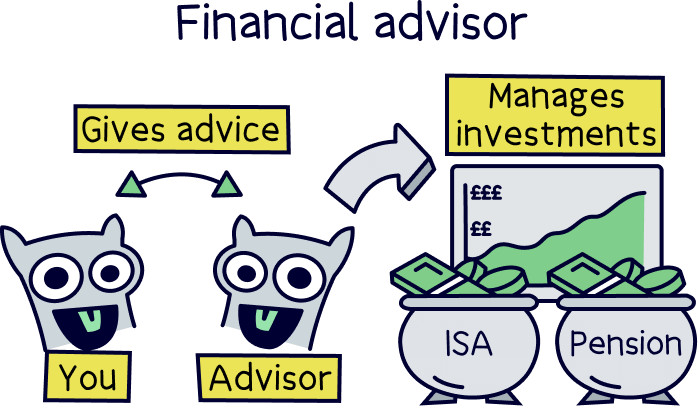
Just before we get any further, we’re talking about ‘defined contribution’ pensions, which are where you save into your pension throughout your life, and has a financial value, often represented as a pension pot (e.g. a £300,000 pension pot).
You are able to decide how much to pay into the pension, and when to take it out (as long as you’re over 55). These are common in most jobs that aren’t Government jobs.
The alternative is a ‘defined benefit’ pension, which are common in Government jobs, and places like the NHS. These are where you’ll get a set income when you retire, for instance a final salary pension, or average salary, and this depends on how long you’ve worked there, and what your salary was when you were employed.
Pension drawdown, or income drawdown, or even flexible drawdown, and flexi-access drawdown (all the same thing), is where you start taking money directly from your pension pot, that’s it. The more you take out, the less it will be worth. Simple right?
If you didn’t know, with all pensions, your money is invested (even now, while you’re working), with the aim of growing it over time. With pension drawdown, you’ll be able to keep your pension invested, so it can keep growing over time.
Although, you may want to consider an investment plan (pension plan) suited to retirement, one that is designed to produce a regular income, or steady growth, rather than a higher risk plan with the potential for more growth (which has bigger ups-and-downs over time).
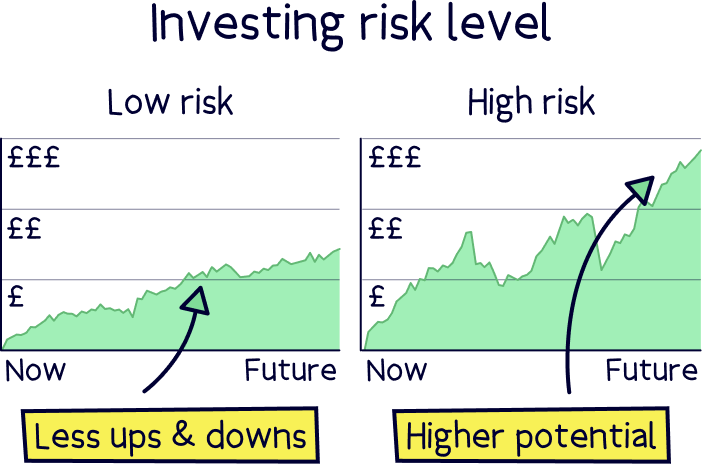
Confused? Your pension drawdown provider can help you choose the right plan, and we’ve run through this in more detail below.
Nuts About Money tip: not many pension providers actually offer pension drawdown (as it’s a new service and it's a bit complicated behind the scenes), so you may find you’ll need to transfer to a pension provider that does offer drawdown…
This is actually a huge, huge benefit for drawdown, picking your own pension provider means you’re able to pick one that’s easy to use, has low fees, provides expert advice, great service, and a great track record of growing pensions over time. The choice is all yours!
We’ve listed our top pension drawdown providers above, but overall, PensionBee¹ is our recommended option, it’s easy to use, low cost, and experts on hand to help with anything for need (for no extra cost).

You could also check out Moneyfarm¹, which is easy to use, and has experts to help, alongside a great record of growing pensions over time.
Pension drawdown came about because of some Government changes in 2015, called the ‘pension freedoms’, which gave you, well, more freedom for your pension, and the ability to withdraw money from your pension from the age of 55 (57 from 2028).
You can also take 25% of your pension tax-free, which applies to both drawdown and annuity (e.g. take it before buying an annuity), which can be taken as a lump sum, or 25% of every withdrawal tax-free (more on tax below).
With drawdown, you’ll be able to withdraw from your pension aged 55 and above (57 from 2028), although it can be a good idea to keep your pension growing for a lot longer if you can, so it can keep growing, and provide a much larger income when you do finally retire.
When you do withdraw it, you can actually still add money to it, but your annual limit will reduce to £10,000 per year – before you withdraw, you can save up to £60,000, or your annual income (e.g. salary) per year, whichever is lower. This reduction is called the Money Purchase Annual Allowance (MPAA).
Across the total of your private pensions (so your total pension pot), you’ll be able to withdraw 25% tax-free, and you can either take this as a tax-free lump sum, or if you have decided to make regular withdrawals, 25% of each withdrawal will be tax-free.
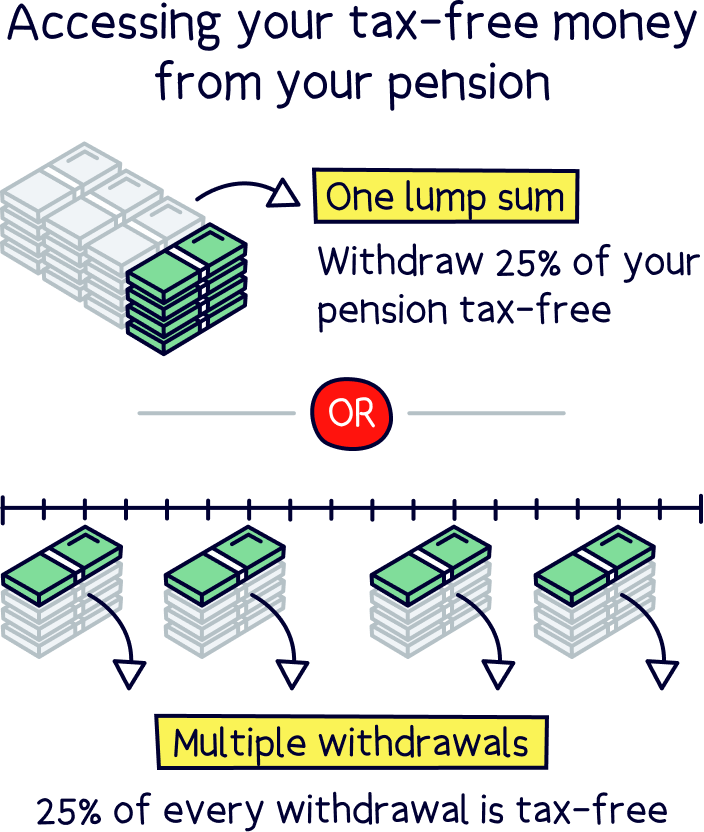
You may pay Income Tax (the same tax as your salary now), on the remaining 75%, depending on your drawdown income at the time – for instance, after you retire, you’ll still be able to earn (withdraw) £12,570 per year before paying tax (just like your job now). We’ve listed the tax rates below.
You can do this with an annuity too – you could take the 25% tax-free lump sum, and then use the 75% to buy an annuity (you’ll still pay Income Tax on the 75%).
There is a maximum amount of £268,275 that you can withdraw tax-free however (you can take more of course, but it will be taxed).
Note: technically the tax-free lump sum is called the pension commencement lump sum (PCLS).
A pension annuity is the more traditional approach to taking your pension in retirement, and it was pretty much the only option before 2015 (when the Government changed the rules to allow pension drawdown).
With annuity, you’ll trade your pension pot for a guaranteed income for the rest of your life, or for a set number of years (for instance 20 years). That means you no longer have the pension pot, and you’ll simply get paid every month.
The actual amount you’ll get each month will vary depending on the size of your pension pot at the time you ‘buy’ the annuity. Your annuity income is typically called an annuity rate.
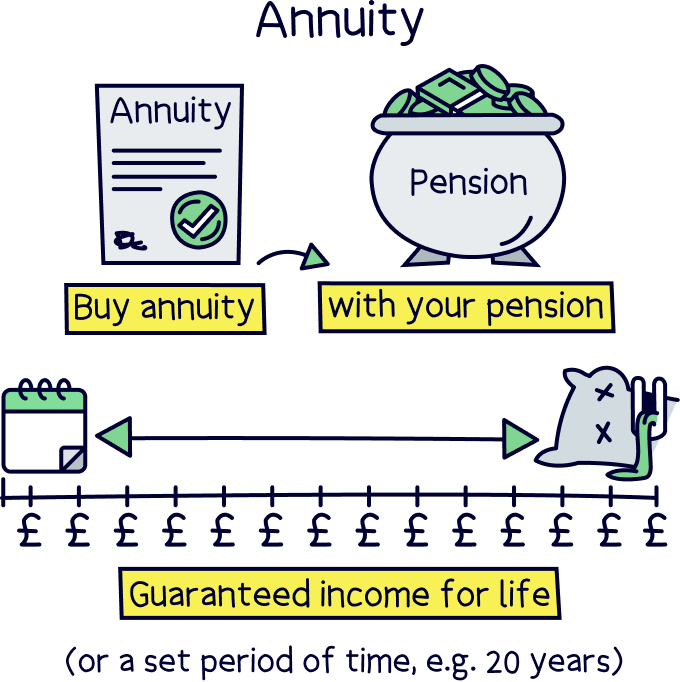
Your health and age play a key role too – you’ll get a bigger retirement income if you buy an annuity when you’re older (e.g. 70 rather 60). And, if you’re overweight or a heavy smoker, you might get more income too (for not so great reasons).
You can also choose to have your annuity increase each year, often in-line with inflation (the price of things (like food) going up over time), however it often means starting retirement with much lower payments (your starting income).
It's important to remind you that you cannot change your annuity, or get a refund, or anything like that once you purchase it – so do take time to consider all your options and if it’s right for you.
Note: an annuity is technically insurance, so you might see this called insurance in some places.
Another very important thing about annuities is that there’s no money left over when you sadly pass away, the annuity provider (company) keeps all the money you had, in return for the guaranteed income. Even if you pass away after only a few years of setting it up.
This means that there will be no money left over for your family (from your pension), if you did want to leave them something.
However, having said that, it is possible to get a joint pension annuity, which can continue to provide an income to your partner (if you have one) – but the monthly payments will typically be lower to start with.
This is called a survivors annuity, and for just one person, it’s called a single life annuity.
With pension drawdown, the full pension pot remains (minus any money you have taken out of it), and you can pass this onto your family when you pass away if you decide to – there’s actually some more beneficial details about drawdown and passing away which we’ll cover below.
We’re sure you’ve guessed the answer to this already, but it’s really all down to you, and your preferences…
It’s different for everyone, and ultimately it comes down to if you prefer the flexibility and control of your money and pension pot in retirement, which comes with drawdown – for instance, if you’d like the regular retirement income, but also the option to change your withdrawals later on, or access a bit more money for a holiday or to help family with their finances (such as a deposit for their home).
Or, if you prefer the stability and guarantee of the pension income each month, which comes with an annuity.
Pension drawdown is becoming very popular thanks to the flexibility, and that the pension pot can keep growing after retirement, and the fact that you can pass it onto a loved one when you pass away.
If you think both could be right for you, you can also do both. It’s totally your choice, and you can keep some of your pension pot invested, and use some of it to buy a cheaper annuity for a smaller guaranteed income.
If pension drawdown sounds like a great option for you, but you’re a bit unsure about the investment side, don’t fret, the Government and pension providers have made that easy (we’ll get to that in a second).
We’ve put together 5 easy steps to set up a drawdown pension:
If you’re not confident making investment decisions, this bit is easy, simply let the experts handle everything – they’ll grow your money sensible over time, and make the right investments to provide you with a regular income.
If you are confident making your investments, you have the option to do that too.
With expert-managed pensions, you’ll simply pick from a few pension plans suited to pension drawdown (usually around 3), we’ll cover the options below.
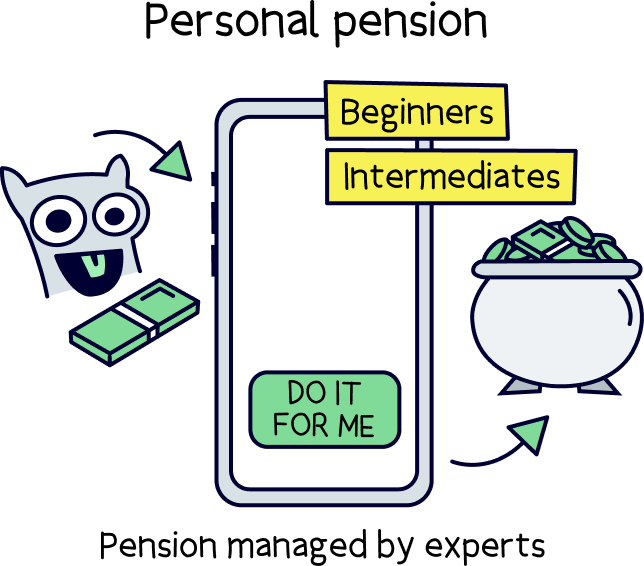
This is typically with a personal pension – which is simply a pension you manage, rather than a pension from your job, called a workplace pension – you transfer your workplace pension to a personal pension when you’re ready to retire (more on transferring below).
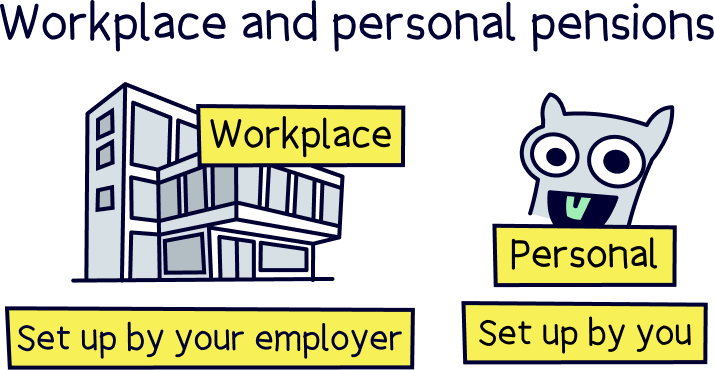
If you’re making your own decisions, you can opt for a self-invested personal pension (SIPP), where you can pick from a huge range of investment options (e.g. shares and funds), and buy and sell them when it suits you. (Only recommended for experienced investors.)
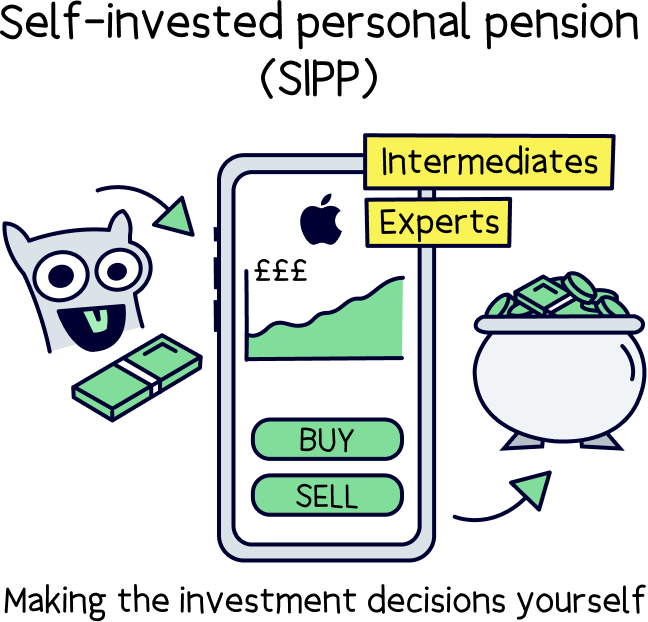
Now it's time to pick the best pension provider for you.
For expert-managed drawdown pensions (where the experts handle all the investments), we recommend checking out PensionBee¹ – it’s easy to use, has low fees, a great track record of growing pensions, and you’ll get a dedicated account manager to help you with any questions you might have (all for free).
We also think Moneyfarm¹ is pretty awesome too. It’s easy to use, has low fees and there’s experts on hand to help you.
For making your own investments, we recommend checking out Interactive Investor¹, it’s low cost, has a huge range of investment options (e.g. pension funds), and great service. You could also check out AJ Bell¹ for all the same reasons. For all the top options, check out the best SIPP providers.
To help you make the right choice when it comes to picking a pension plan from any provider, but mostly from an expert-managed pension provider, the Government has come up with 4 common options, called ‘Investment Pathways’, which are:
One of these options should suit most people, and we can see that if you’re looking to retire soon, you’ll probably be opting for option 2 or 3.
Note: a pension plan can also be called a pension fund.
So, with a top expert-managed pension provider, such as PensionBee¹, they’ve matched their pension plans with these options, so all you need to do is pick the pension plan for that ‘pathway’.
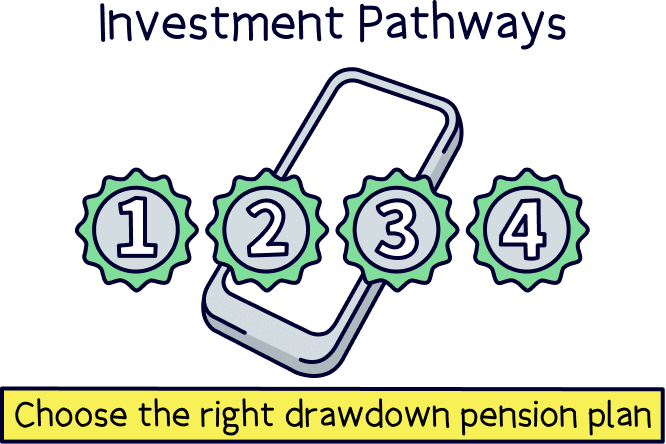
Here’s the 4 pathway options that PensionBee offer:
So, if you’re planning to opt for pension drawdown for retirement, you’d simply pick the ‘4Plus’ plan, and your pension should grow steadily over time, while you’re able to withdraw from it. Easy right?
If you’re still a bit unsure, there’s experts on hand to run through all your options too.
Note: equities means shares in companies (ownership of companies), and fixed income means investments that provide a regular income, and considered safe investments, such as loans to Governments and large corporations in return for interest payments.
Next, if you’re happy with the provider, and the pension plan option, it’s time to transfer your existing pension across to your new provider, so that you can retire with your pension drawdown (whoop!).
This bit is really easy to do. All the best pension providers will simply handle everything for you – all you need to do is let them know where your existing pension is and they’ll handle the whole transfer process for you – your money will simply turn up in your account after a few weeks.
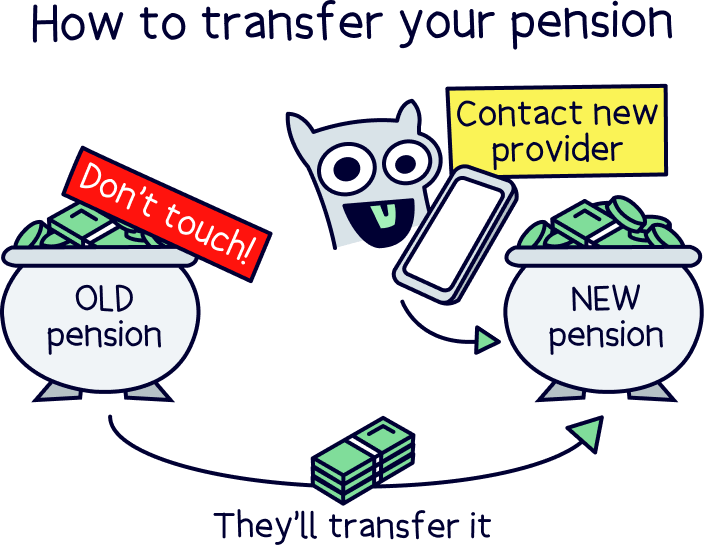
If you’re not quite sure where your old pensions are, get in touch with your old jobs and they’ll let you know, or try the Government's pension tracing service, or Gretel.
And that’s it. Time to put your feet up and retire, with a pension ready to provide you with a regular income.
Well, you will have to decide how much you’d like to take out of your pension each month, and that’s entirely up to you. Everything else is handled behind the scenes (such as any tax paid if you need to pay it).
Remember, you’ll also get 25% completely tax-free, and you can take this as a lump sum if you like.
An annuity can be a lot more complicated to get started, and there’s lots of information to look over and decide on – and it’s best not to rush into anything until you’re definitely sure, as there’s no going back.
We recommend speaking to a financial advisor so they can determine the best option for you, and find you the best annuity that suits you and your individual circumstances (such as if you’d like to share an annuity with your partner).
For more information, the largest annuity providers are Aviva and Legal & General – but it’s still best to use a financial advisor.
To find great financial advisors local to you, check out Unbiased¹, it’s a free service to find fully qualified advisors on pensions.
Picking either option will effectively be the same for tax reasons, and that’s because both options count as ‘income’, and so you’ll pay Income Tax on however much you withdraw each month, if it’s above your tax-free allowance.
Note: you’d also include the State Pension (the Government pension) income as part of your income for tax reasons too. That’s what you’ll get at 66 years old if you’ve paid at least 10 years worth of National Insurance contributions (35 years to get the full amount).
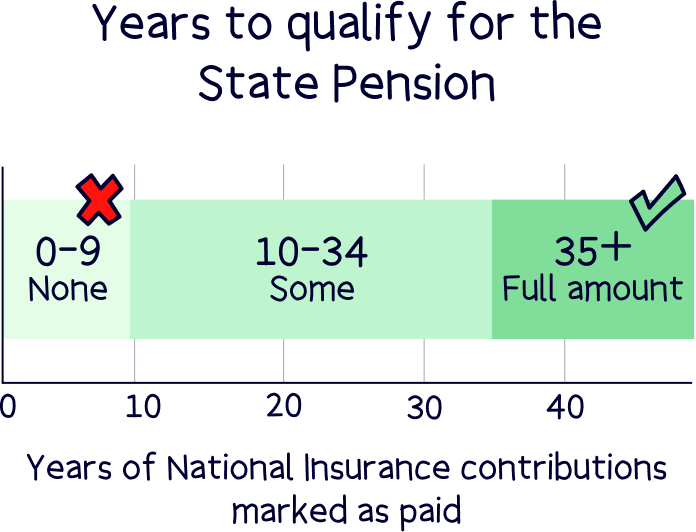
So, currently, here’s what you’d pay:
However, 25% will be tax-free, you choose how to take it (e.g. as a lump sum before buying a lifetime annuity, or 25% of every withdrawal with drawdown).
By the way, you won’t typically have to worry about paying tax yourself, your drawdown pension provider, or annuity provider, will typically do that for you, just as your job does now (if you’re employed) – you just get the amount after tax to spend. Technically, this is called PAYE (Pay As You Earn).
There's one major tax advantage we should clarify, and that is your pension will still continue to grow tax-free within your pension pot – so it can keep growing over time, just as it has done throughout your life, tax-free. You only pay tax on any money you take out of your pension.
An important factor when deciding whether to buy a lifetime annuity or opt for pension drawdown is what happens when you pass away.
With an annuity, when you pass away, your pension pot effectively disappears too, and the annuity provider keeps it. You can opt for a joint annuity to provide income to your partner after you’ve sadly passed away, but this will typically mean your income payments are significantly reduced.
With pension drawdown, your pension pot is still all yours (well you can't take it with you) but it remains after you pass away. This means your pension will actually pass to whoever you specify, called your beneficiary, and it can be more than one person.
And, if you die before 75, your pension pot passes to your beneficiaries completely tax-free. After 75, whoever receives your pension pot will have to pay Income Tax on any money they withdraw from it.
This means you don’t pay any Inheritance Tax on your pension, and it doesn’t count towards your ‘estate’, which is all of your assets added together (such as property and cash), which will be liable for Inheritance Tax.
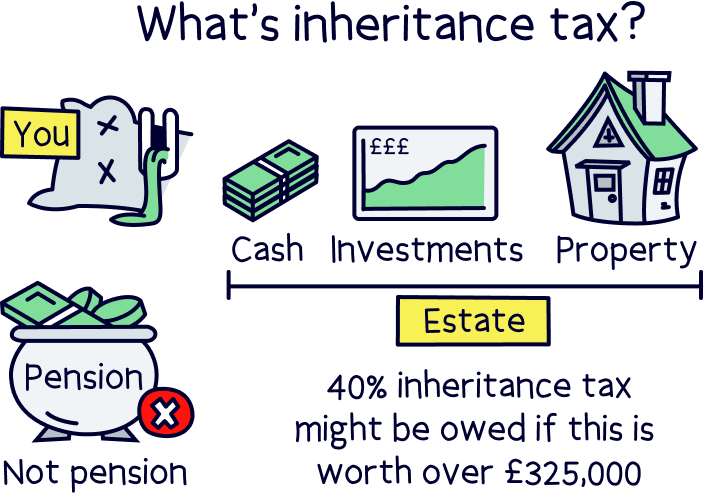
This is a massive advantage of pensions in general, if you opt for a drawdown it can act as a form of life insurance for your family.
If you’re still a bit unsure on everything, don’t worry, it’s a complicated topic, but there’s more help out there.
If you’re over 50, you can speak to a pensions expert on the phone, all for free, with Pension Wise, a service from MoneyHelper (a Government scheme to help people with their finances).
You could also speak to a financial advisor, and they can run through all your options (for a fee).
There we have it, annuity vs drawdown. It's a complicated topic, but we hope that made things a bit clearer.
Overall, it’s completely up to you which one is best, there’s no best option in general.
Pension annuity is a great option if you’d prefer a guaranteed, steady income for life, and not have to worry about your pension again.
Otherwise, pension drawdown is a great option, because you decide how much you’d like to withdraw from your pension, and when you’d like to, while your pension pot can keep growing over time (and managed by experts).
This gives you the flexibility to withdraw more in future if you’d like to, too. For instance for big holidays or helping family with their finances (such as getting on the property ladder).
And your pension pot will remain after you pass away, which can be passed onto your family (this isn’t an option with annuity).
With both options, you’ll be able to take a 25% tax-free lump sum if you want to, from age 55 (57 from 2028).
If pension drawdown is for you, we recommend checking out PensionBee¹, it’s easy to use, has low fees, a great track record of growing pensions over time, and you’ll get a dedicated account manager to answer any questions you might have, and run through your options.
Moneyfarm¹ is also a great choice, and offers expert guidance, while being easy to use, and low cost.
If you’re thinking of getting an annuity, it’s a good idea to speak to a financial advisor. You can find great ones local to you with Unbiased¹.
And that’s it. All the best for a happy retirement.
We recommend PensionBee, it’s easy to set up and use, low cost, with simple, easy to understand drawdown options.
We’d love to hear from you, and it will help others too.
We recommend PensionBee, it’s easy to set up and use, low cost, with simple, easy to understand drawdown options.